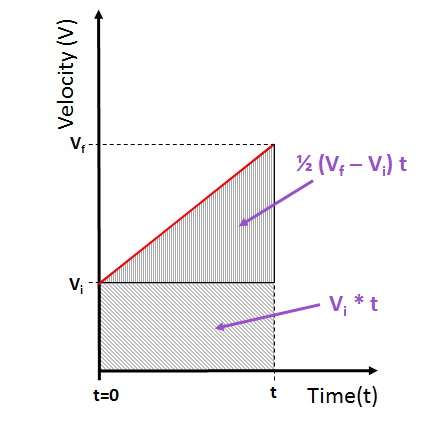Final Velocity - f(a,dx)
Tags | |
UUID | 4185609d-b962-11e5-9770-bc764e2038f2 |
This Final Velocity equation (V_f = sqrt( V_i^2 + 2*a*Delta x)) computes the final velocity(Vf) that a body would achieve after traveling in a straight line some distance (?x) at constant acceleration (a) with an initial velocity (V0).
INSTRUCTIONS: Choose your preferred units and enter the following:
- (?x) - the total displacement or distance travelled
- (a) - the constant acceleration
- (V0) - the initial velocity
The calculator returns the final velocity (Vf) in meters per second. However this can be automatically converted to other velocity units via the pull-down menu.
This an illustrative step in calculating the actual v_f based on acceleration and time. See the derivation below.
References
- Light and Matter(Dr. Benjamin Crowell) Chapter 3.6 Algebraic results for constant acceleration
The Math

Since acceleration is constant, we know that the final velocity is the sum of the initial velocity and the velocity increase due to the acceleration. In other words:
[1] V_f = V_i + a * t
We also know that the distance traveled, d, is the sum of the distance the object would travel at its starting velocity, V_i, plus the distance it would travel while increasing velocity from V_i to V_f:
[2] D = (V_i * t) + (1/2 * (V_f - V_i) * t)
[3] D = t * (V_i + 1/2 * V_f - 1/2 * V_i)
[4] D = t * 1/2 (V_i + V_f)
[5] => t = (2 * D) / (V_i + V_f)
Substituting [5} into [1]:
[6] V_f = V_i + a * ((2 * D) / (V_i + V_f))
Multiplying both sides by '(V_i + V_f)`:
[7] V_i *V_f + V_f^2 = V_i^2 + V_i * V_f + 2*A*D
Cancelling term V_i* V_f:
[8] V_f^2 = V_i^2 + 2*a*D, where D = x_f - x_0
So, finally:
[9] V_f^2 = V_i^2 + 2*a*(x_f - x_0)
This equation computes the resultant as V_f^2, which is not useful in most cases. Therefore:
[10]V_f = sqrt( V_i^2 + 2*a*(x_f - x_0))
Assuming no initial distance (x0 = 0), and renaming xf to Delta x,
[11]V_f = sqrt( V_i^2 + 2*a*Delta x)
EXTERNAL LINKS
Khan Academy's Average velocity for constant acceleration
- Comments
- Attachments
- Stats
No comments |
